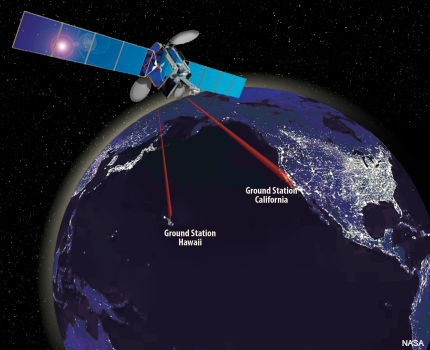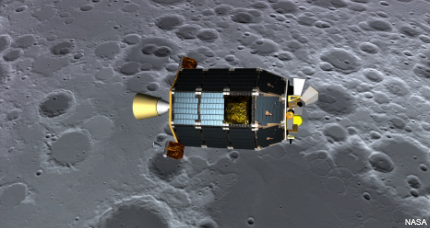The potential benefits of a laser-based interplanetary Internet
NASA’s successful laser communications demonstration in lunar orbit could pave the way for expanding bandwidth on Earth.

Optical communications systems will be able to transmit data at rates 10 to 100 times faster than radio-based communications.
A NASA laser communications demonstration that succeeded in transmitting high-rate data to the moon and back has laid the groundwork for an even more ambitious laser relay demonstration scheduled for as early as 2017. Ultimately, the technology also could expand satellite options for bandwidth-strapped Defense Department agencies.
The Lunar Laser Communication Demonstration (LLCD), carried aboard a NASA lunar orbiter, successfully transmitted data at a record rate of 622 megabits per second on Oct. 17, 2013. The optical system delivered six times the bandwidth of standard radio-frequency communications networks now used for space communications.
The two-way optical system also demonstrated an error-free upload rate of 20 megabits per second.
A future optical relay network could serve as the basis for an interplanetary Internet with data rates as much as 100 times faster than those of conventional communication satellites with the same mass and power, NASA claims.
The download rate of the 0.5-watt laser system used in the lunar demonstration is roughly equivalent to streaming 30 HDTV channels simultaneously, program managers said. Measured another way, they said a Google map of Mars using current communications technology would require nine years. A future laser communications network with adequate relays could reduce mapping time to nine weeks.
NASA Administrator Charles Boldin noted in a message transmitted to the moon via the laser system that LLCD is a precursor to a more ambitious demonstration planned for as early 2017 called the Laser Communications Relay Demonstration.
"With optical communications, we'll be able to transmit more data so that future rovers on other planets and human missions to an asteroid and Mars will enjoy Internet-like connections," Boldin said. He also claimed commercial satellites using optical communications could provide "unlimited bandwidth" back on Earth.
Such a capability would be of great interest to the military services that are currently scrambling to squeeze more capacity out of crowded electromagnetic spectrum in order to accommodate unmanned platforms, sensors and other devices while freeing up some of the spectrum it has for commercial use.
The Defense Advanced Research Projects Agency has been working to reduce the size, weight and power requirements of high-energy lasers that could be used in weapons or for high-bandwidth communications. Its Excalibur program recently demonstrated a 21-element optical phased array that pointed a laser beam at a target more than four miles away. Along with reducing power consumption, Excalibur corrected for atmospheric turbulence.
Cloud cover was also an issue during last fall's NASA demonstration. During 50 test passes, clouds sometimes obscured the White Sands, N.M., ground station. Mission managers were able to shift operations to a Jet Propulsion Laboratory (JPL) facility at Table Mountain, Calif. A second option in Spain at 14,000 feet was well above the cloud deck.
Still, NASA managers have already launched an effort to make future laser-based space networks "delay- and disruption-tolerant." The reason, acknowledged David Israel, NASA's principle investigator for the laser relay demonstration: "Clouds happen."
For last fall's demonstration, "The real trick was pointing a very narrow laser beam from 239,000 miles away to a four-mile area" at a ground station in White Sands, LLCD mission manager Don Cornwell said. The initial challenge in pointing a laser in lunar orbit was accounting for the 1.5-second time difference it takes for a beam of light to reach Earth from the moon. Hence, controllers at NASA's Goddard Space Flight Center in Maryland had to point the laser beam slightly ahead of the prime ground station, much as a quarterback leads a receiver on a long pass in football.
The second challenge was overcoming spacecraft vibration that could affect the accuracy of the laser pointer. Slight vibrations were measure and cancelled out, but Cornwell said the slight oscillations were not as bad as expected.
"Pointing and tracking was our biggest concern," but locking the laser beam onto its ground station target turned out to be one of the easiest parts of the demonstration, Cornwell said in an interview. Since the optical system operated error-free while downloading and uploading data on each of 50 passes, program managers said very little troubleshooting was required. Hence, they were able to focus on different operational profiles like transmitting data when the moon was setting.
LLCD hitched a ride aboard NASA's Lunar Atmosphere and Dust Environment Explorer, which scanned the lunar horizon for signs of a faint atmosphere. That part of the mission was less successful, and the low-flying LADEE crashed into moon on April 17, a day or so earlier than expected.

The LADEE spacecraft hosted the laser demonstration from lunar orbit.
The laser relay demonstration will be carried to geosynchronous orbit in 2017 or 2018 as a hosted payload aboard a commercial communications satellite being built by Space Systems/Loral. SSL will host the laser relay demonstration under a $3 million NASA contract. The space agency said the deal marks the first time a NASA payload will be flown on a U.S.-made commercial communications satellite.
MIT Lincoln Laboratories, which provided optical modules for the first laser communications demonstration, also is working with the Goddard Center and JPL on the upcoming relay demonstration.
Building on last year's success, the two-year laser relay project will demonstrate optical relay techniques that would bring an operational laser-based communications network closer to reality. If the technology works, Israel said, the next step is "can we make it operational? … It's really about the scalability" of space communications networks.
The ambitious laser relay experiment will attempt to demonstrate that data from one optical link can be relayed to another link. Two ground stations would "work on the whole hand-over aspect" of the demonstration, Israel said. Other planned experiments include multiplexing data for use by multiple users at different locations and demonstrating a DVR-like "store/forward" capability that would allow video, for example, to be stored and relayed later at lower data rates.
Current rover operations on Mars require that orbiting RF communication satellites be in the proper line-of-site position to relay commands back and forth between mission managers on Earth and the Curiosity and Opportunity rovers. An operational laser relay network could someday provide a "24-hour view" of surface operations by relaying data from the far side of Mars or the moon.
Israel also is working the Interplanetary Networking Special Interest Group to make a future Internet-in-space a reality. Along with developing "opportunistic networks" that can adjust, for example, to a ground station socked in by clouds, the group is also trying to leverage emerging software-defined network technology that is currently all the rage in the terrestrial communications sector.
The networking group is also looking for way to use space communications to boost the bandwidth of the terrestrial Internet.